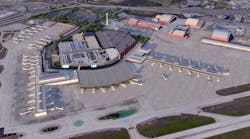... yet no one in the general aviation community seems to agree. Last fall, the Transportation Security Administration proposed its Large Aircraft Security Program (LASP). At five public hearings since and in scores of comments to the agency, the GA sector has stood up and shouted a collective “No way.†Will the ‘partner’ listen?
Perhaps the best line from TSA’s website on the announcement of the program is this: “Establishing common sense standards for operators of these larger, and typically highly-capable aircraft, will enhance security for the nation's general aviation operations.†Actually, “common sense standards†is exactly what the industry is calling for; no one seems to find any in the LASP.
Also from TSA: “The Large Aircraft Security Program (LASP) regulation would require all U.S. operators of aircraft exceeding 12,500 pounds maximum take-off weight to implement security programs that would be subject to compliance audits by TSA. The proposed regulation would also require operators to verify that passengers are not on the No Fly and/or Selectee portions of the federal government's consolidated terrorist watch list.â€
TSA plasters the word “partner†all over their announcement. Apparently, folks from the agency went to a different dance than the GA community.
At the American Association of Airport Executives (AAAE), a General Aviation Security Working Group filed comments that include: “This proposed rule requires additional substantive analysis on impacts and should include revisions that reflect the operational reality of thousands of general aviation facilities across the country. TSA also should create a general aviation rulemaking committee comprised of general aviation associations representing operators, pilots, manufacturers, and above all, airports, in addition to the TSA and relevant DHS divisions.â€
As part of its analysis of the proposed rulemaking, AAAE and the working group conducted a survey of GA airports. Among the survey findings:
More than 90 percent of respondents reported that they would be charged by their local law enforcement agency for any costs associated with the new regulations, which TSA completely omitted from their own fiscal impact analysis;
88 percent of FAA-designated reliever airports would consider passing on the cost of the LASP to aircraft operators;
60 percent of FAA designated reliever airports estimate the cost of the LASP above $40,000 per year, and several responded that the cost would be well over $200,000 per year; and
71 percent of FAA designated reliever airports do not think the NPRM will improve security.
Ed Bolen, president of the National Business Aviation Association, says “this proposal completely misses the mark. The TSA needs to understand that in preparing the LASP, the agency has attempted to overlay a security regime for the big airlines onto tens of thousands of businesses all across the country. If left unchanged, the plan would overwhelm these small businesses in a time of economic crisis without providing a clear security benefit.â€
The National Air Transportation Association (NATA) suggests scrapping the proposal altogether. Comments NATA president Jim Coyne, “Overall, this NPRM demonstrates a troubling lack of knowledge and understanding of the general aviation community by the TSA."
One of the biggest concerns, says NATA, is the economic impact the proposed rule will have on the general aviation industry with little justification by TSA validating its issuance. "The public should be permitted to review the agency's justification for this rule. The Administration Procedure Act/Regulatory Flexibility Act requires a federal agency to weigh the costs of a proposed regulation against the anticipated benefits. The public has been unable to validate the TSA's pronouncement that the benefits of this proposed rule in fact outweigh the costs because of the agency's unwillingness to share data," says the association.
“ NATA and other industry members once again ask the TSA to accept their offer of assistance. The only acceptable action for the agency to take is to withdraw the NPRM and assemble an official rulemaking committee, following the FAA's Aviation Rulemaking Committee (ARC) model or similar.â€
If TSA truly wants to regulate in partnership with the industry, it will find a willing industry, as the comments above suggest. Forming a rulemaking committee makes sense, and perhaps the industry participants taking part would be able to further educate TSA on general aviation. Should we ever get to that step, I’d suggest recruiting NetJets president Jim Christiansen to head it up. He was instrumental as chair of the FAA rulemaking committee that helped the agency tread through the waters when fractionals became a player and the subsequent Part 91-Subpart K was achieved.
The time has come for TSA to get a clearer handle on GA. The shadows it sees behind every corner are likely just that – shadows.
Thanks for reading. jfi



